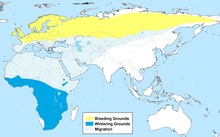Fitis
| Fitis | ||||||||||||
|---|---|---|---|---|---|---|---|---|---|---|---|---|

Fitis ( Phylloscopus trochilus ) |
||||||||||||
| Systematics | ||||||||||||
|
||||||||||||
| Scientific name | ||||||||||||
| Phylloscopus trochilus | ||||||||||||
| ( Linnaeus , 1758) |
The Willow Warbler ( Phylloscopus trochilus ), also Fitislaubsänger called, is a songbird from the genus of warblers ( Phylloscopus ) and the family of the warbler-like (Phylloscopidae). Several subspecies are distinguished. The nominate form Phylloscopus trochilus trochilus is a widespread and very frequent breeding and summer bird in Central Europe.
description
The Fitis is about eleven to thirteen centimeters long and has a wingspan of 17 to 22 centimeters. The weight is about eight to eleven grams. It is difficult to distinguish in appearance from the chiffchaff ( Phylloscopus collybita ). The upper side is green to olive brown, its underside yellowish white. The little bird has a yellowish throat, chest and over-eye stripes . Males and females have the same coloration.
A fitis can live up to twelve years.
Delimitation to the chiffchaff
In Central Europe, the Fitis is easy to confuse with the very similar and also common chiffchaff; they are twin species . The Fitis is a bit slimmer and more long-winged than the Chiffchaff. The legs of the Fitis are usually noticeably lighter, the stripe above the eye is longer and more pronounced, especially behind the eye. The hand swing projection, i.e. the protrusion of the hand swing over the screen springs , is much larger in the Fitis. Furthermore, in the chiffchaff, the fifth hand swing from the inside has a narrowing on the outer flag, which is missing there in the Fitis. However, this reliable distinguishing feature can only be recognized if you hold the animals in your hand.
On the basis of the song, however, the distinction is not a problem, because this is very different for the two species. The Fitis sings in melodiously sloping melodies, whereas the Chiffchaff can easily be recognized by its two-syllable chiffchaff-Zalp singing. The call of the Fitis is clearly two-syllable ("hu-it") and rising in pitch, and the chiffchaff is short and hard ("huit").
habitat
The long-distance migrant is present in almost all of Central and Northern Europe from April to September. He has his winter quarters south of the Sahara in Africa . It covers a distance of between 6,000 and 13,000 kilometers by train. Departure time and direction of movement are innate to him. The Fitis lives in light deciduous and mixed forests , parks , wetlands , shrubbery and gardens .
nutrition
The fitis feeds on spiders , mollusks, berries , fruits, insects and their larvae .
voice
The singing of Fitis is reminiscent of that of the chaffinch , but is much softer and more rustled.
Reproduction

The sexual maturity occurs after one year. The main breeding season is May to July. Consisting of moss and grass built nest of ground-breeder reactor , which has a canopy with a side entrance, is well hidden in thick bushes or grass. The female lays four to seven eggs . The eggs are warmed for 12 to 14 days. The young birds stay in the nest for 13 to 14 days. A second brood often occurs in southern areas.
Duration
The European population is estimated at 40 million breeding pairs, the population in Germany at 1.8 to 2.4 million pairs. In 2008 the species is in 14th position in the list of common breeding bird species. Depending on climatic conditions and habitat changes, there are local and regional significant short-term population fluctuations of up to fifty percent. Due to the high rate of offspring of this species, the population is usually rebuilt quickly.
There have been some area expansions in Northern Europe since the 19th century. These are both climate-related and a change in forest management or favorable habitat developments. The Fitis, for example, settled on the Frisian Islands after more trees were planted there.
literature
- Hans-Günther Bauer, Einhard Bezzel , Wolfgang Fiedler (eds.): The compendium of birds in Central Europe: Everything about biology, endangerment and protection. Volume 2: Passeriformes - passerine birds. Aula-Verlag Wiebelsheim, Wiesbaden 2005, ISBN 3-89104-648-0 .
Web links
- A real long-distance migrant - The Fitis (with bird's voice)
- Phylloscopus trochilus in the endangered Red List species the IUCN 2008. Posted by: BirdLife International, 2008. Accessed on December 23 of 2008.
- Videos, photos and sound recordings for Phylloscopus trochilus in the Internet Bird Collection
- Feathers of the fitis
Individual evidence
- ↑ Detlef Singer: What is flying there? Franck-Kosoms-Verlags-GmbH & Co KG, Stuttgart 2016, ISBN 978-3-440-15089-4 , p. 88.
- ↑ cf. Sudfeldt, C., R. Dröschmeister, C. Grüneberg, S. Jaehne, A. Mitschke & J. Wahl (2008): Birds in Germany - 2008. DDA, BfN, LAG VSW, Münster, page 7. Full text, pdf
- ↑ Bauer et al., P. 187



